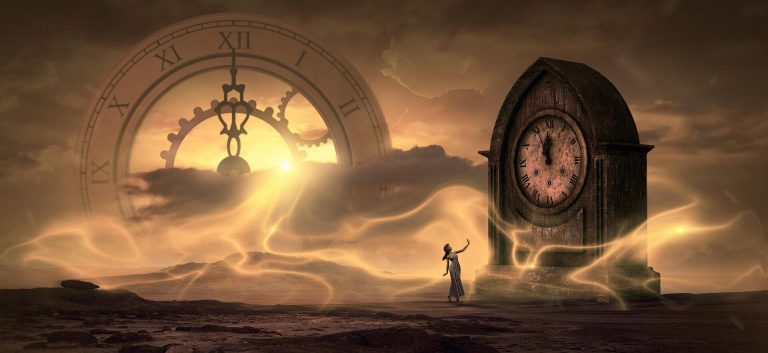
What are Angels?
From Wikipedia

An angel is generally a supernatural being found in various religions and mythologies. Abrahamic religions often depict angels as benevolent celestial beings who act as intermediaries between God (or Heaven) and humanity. Other roles of angels include protecting and guiding human beings, and carrying out tasks on behalf of God. Abrahamic religions often organize angels into hierarchies, although such rankings may vary between sects in each religion. Such angels may receive specific names (such as Gabriel or Michael) or titles (such as seraph or archangel). People have also extended the use of the term “angel” to various notions of spirits or figures found in other religious traditions. The theological study of angels is known as “angelology”. Angels expelled from Heaven are referred to as fallen angels as distinct from the heavenly host.
In fine art angels are usually depicted as having the shape of human beings of extraordinary beauty but no gender (until the 19th century at least). They are often identified In Christian artwork with bird wings, halos, and light.
Etymology
The word angel arrives in modern English from Old English engel (with a hard g) and the Old French angele. Both of these derive from Late Latin angelus (literally “messenger”), which in turn was borrowed from Late Greek ἄγγελος aggelos, commonly transliterated by non-Greek speakers in its phonetic form ángelos. Additionally, per Dutch linguist R. S. P. Beekes, ángelos itself may be “an Oriental loan, like ἄγγαρος (ángaros, ‘Persian mounted courier’).” Perhaps then, the word’s earliest form is Mycenaean a-ke-ro, attested in Linear B syllabic script.
The rendering of “ángelos” is the Septuagint’s default translation of the Biblical Hebrew term mal’ākh, denoting simply “messenger” without connoting its nature. In the associations to follow in the Latin Vulgate, this meaning becomes bifurcated: when mal’ākh or ángelos is supposed to denote a human messenger, words like nuntius or legatus are applied. If the word refers to some supernatural being, the word angelus appears. Such differentiation has been taken over by later vernacular translations of the Bible, early Christian and Jewish exegetes and eventually modern scholars.
Abrahamic religions
Judaism
Tobias and the Angel by Filippino Lippi, created between circa 1472 and circa 1482.
The Torah uses the (Hebrew) terms מלאך אלהים (mal’āk̠ ‘ĕlōhîm; messenger of God), מלאך יהוה (mal’āk̠ YHWH; messenger of the Lord), בני אלהים (bənē ‘ĕlōhîm; sons of God) and הקודשים (haqqôd̠əšîm; the holy ones) to refer to beings traditionally interpreted as angels. Later texts use other terms, such as העליונים (hā’elyônîm; the upper ones).
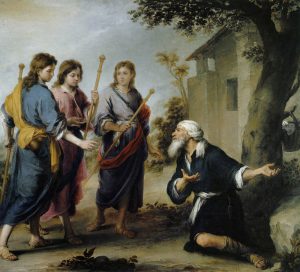 The term מלאך (mal’āk̠) is also used in other books of the Tanakh. Depending on the context, the Hebrew word may refer to a human messenger or to a supernatural messenger. A human messenger might be a prophet or priest, such as Malachi, “my messenger”; the Greek superscription in the Septuagint translation states the Book of Malachi was written “by the hand of his messenger” ἀγγέλου angélu. Examples of a supernatural messenger are the “Malak YHWH,” who is either a messenger from God, an aspect of God (such as the Logos), or God himself as the messenger (the “theophanic angel.”)
The term מלאך (mal’āk̠) is also used in other books of the Tanakh. Depending on the context, the Hebrew word may refer to a human messenger or to a supernatural messenger. A human messenger might be a prophet or priest, such as Malachi, “my messenger”; the Greek superscription in the Septuagint translation states the Book of Malachi was written “by the hand of his messenger” ἀγγέλου angélu. Examples of a supernatural messenger are the “Malak YHWH,” who is either a messenger from God, an aspect of God (such as the Logos), or God himself as the messenger (the “theophanic angel.”)
Scholar Michael D. Coogan notes that it is only in the late books that the terms “come to mean the benevolent semi-divine beings familiar from later mythology and art.” Daniel is the first biblical figure to refer to individual angels by name, mentioning Gabriel (God’s primary messenger) in Daniel 9:21 and Michael (the holy fighter) in Daniel 10:13. These angels are part of Daniel’s apocalyptic visions and are an important part of all apocalyptic literature.
In Daniel 7, Daniel receives a dream-vision from God. As Daniel watches, the Ancient of Days takes his seat on the throne of heaven and sits in judgement in the midst of the heavenly court an angel like a son of man approaches the Ancient One in the clouds of heaven and is given everlasting kingship.
Coogan explains the development of this concept of angels: “In the postexilic period, with the development of explicit monotheism, these divine beings—the ‘sons of God’ who were members of the Divine Council—were in effect demoted to what are now known as ‘angels’, understood as beings created by God, but immortal and thus superior to humans.” This conception of angels is best understood in contrast to demons and is often thought to be “influenced by the ancient Persian religious tradition of Zoroastrianism, which viewed the world as a battleground between forces of good and forces of evil, between light and darkness.” One of these is hāšāṭān, a figure depicted in (among other places) the Book of Job.
Philo of Alexandria identifies the angel with the Logos inasmuch as the angel is the immaterial voice of God. The angel is something different from God himself, but is conceived as God’s instrument.
Four classes of ministering angels minister and utter praise before the Holy One, blessed be He: the first camp (led by) Michael on His right, the second camp (led by) Gabriel on His left, the third camp (led by) Uriel before Him, and the fourth camp (led by) Raphael behind Him; and the Shekhinah of the Holy One, blessed be He, is in the centre. He is sitting on a throne high and exalted.
In post-Biblical Judaism, certain angels took on particular significance and developed unique personalities and roles. Although these archangels were believed to rank among the heavenly host, no systematic hierarchy ever developed. Metatron is considered one of the highest of the angels in Merkabah and Kabbalist mysticism and often serves as a scribe; he is briefly mentioned in the Talmud and figures prominently in Merkabah mystical texts. Michael, who serves as a warrior and advocate for Israel (Daniel 10:13), is looked upon particularly fondly. Gabriel is mentioned in the Book of Daniel (Daniel 8:15–17) and briefly in the Talmud, as well as in many Merkabah mystical texts. There is no evidence in Judaism for the worship of angels, but there is evidence for the invocation and sometimes even conjuration of angels.
 According to Kabbalah, there are four worlds and our world is the last world: the world of action (Assiyah). Angels exist in the worlds above as a ‘task’ of God. They are an extension of God to produce effects in this world. After an angel has completed its task, it ceases to exist. The angel is in effect the task. This is derived from the book of Genesis when Abraham meets with three angels and Lot meets with two. The task of one of the angels was to inform Abraham of his coming child. The other two were to save Lot and to destroy Sodom and Gomorrah.
According to Kabbalah, there are four worlds and our world is the last world: the world of action (Assiyah). Angels exist in the worlds above as a ‘task’ of God. They are an extension of God to produce effects in this world. After an angel has completed its task, it ceases to exist. The angel is in effect the task. This is derived from the book of Genesis when Abraham meets with three angels and Lot meets with two. The task of one of the angels was to inform Abraham of his coming child. The other two were to save Lot and to destroy Sodom and Gomorrah.
Jewish philosopher Maimonides explained his view of angels in his Guide for the Perplexed II:4 and II
… This leads Aristotle in turn to the demonstrated fact that God, glory and majesty to Him, does not do things by direct contact. God burns things by means of fire; fire is moved by the motion of the sphere; the sphere is moved by means of a disembodied intellect, these intellects being the ‘angels which are near to Him’, through whose mediation the spheres move … thus totally disembodied minds exist which emanate from God and are the intermediaries between God and all the bodies [objects] here in this world.
— Guide for the Perplexed II:4, Maimonides
Maimonides had a neo-Aristotelian interpretation of the Bible. Maimonides writes that to the wise man, one sees that what the Bible and Talmud refer to as “angels” are actually allusions to the various laws of nature; they are the principles by which the physical universe operates.
For all forces are angels! How blind, how perniciously blind are the naive?! If you told someone who purports to be a sage of Israel that the Deity sends an angel who enters a woman’s womb and there forms an embryo, he would think this a miracle and accept it as a mark of the majesty and power of the Deity, despite the fact that he believes an angel to be a body of fire one third the size of the entire world. All this, he thinks, is possible for God. But if you tell him that God placed in the sperm the power of forming and demarcating these organs, and that this is the angel, or that all forms are produced by the Active Intellect; that here is the angel, the “vice-regent of the world” constantly mentioned by the sages, then he will recoil.– Guide for the Perplexed II:4
The sons of God saw the Daughters of Men that they were fair by Maurice Greiffenhagen
Maimonides, in his Yad ha-Chazakah: Yesodei ha-Torah, counts ten ranks of angels in the Jewish angelic hierarchy, beginning from the highest:
Rank Angel Notes
1 Chayot Ha Kodesh See Ezekiel 1,10
2 Ophanim See Ezekiel 1,10
3 Erelim See Isaiah 33:7
4 Hashmallim See Ezekiel 1:4
5 Seraphim See Isaiah 6
6 Malakim Messengers, angels
7 Elohim “Godly beings”
8 Bene Elohim “Sons of Godly beings”
9 Cherubim See Hagigah 13b
10 Ishim “manlike beings”, see Genesis 18:2, Daniel 10:5
Individual angels
From the Jewish Encyclopedia, entry “Angelology”.
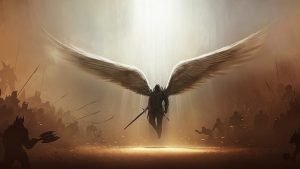 Michael (archangel) (translation: who is like God?), kindness of God, and stands up for the children of mankind
Michael (archangel) (translation: who is like God?), kindness of God, and stands up for the children of mankind
Gabriel (archangel) (translation: God is my strength), performs acts of justice and power
(Only these two angels are mentioned by name in the Hebrew Bible; the rest are from extra-biblical tradition.)
Jophiel (translation: Beauty of God), expelled Adam and Eve from the Garden of Eden holding a flaming sword and punishes those who transgress against God.
Raphael (archangel) (translation: It is God who heals), God’s healing force
Uriel (archangel) (translation: God is my light), leads us to destiny
Samael (archangel) (translation: Venom of God), angel of death—see also Malach HaMavet (translation: the angel of death)
Sandalphon (archangel) (translation: bringing together), battles Samael and brings mankind together.
Christianity
Later Christians inherited Jewish understandings of angels, which in turn may have been partly inherited from the Egyptians. In the early stage, the Christian concept of an angel characterized the angel as a messenger of God. Later came identification of individual angelic messengers: Gabriel, Michael, Raphael, and Uriel. Then, in the space of little more than two centuries (from the 3rd to the 5th) the image of angels took on definite characteristics both in theology and in art
According to St. Augustine, ” ‘Angel’ is the name of their office, not of their nature. If you seek the name of their nature, it is ‘spirit’; if you seek the name of their office, it is ‘angel’: from what they are, ‘spirit’, from what they do, ‘angel’.” Basilian Father Thomas Rosica says, “Angels are very important, because they provide people with an articulation of the conviction that God is intimately involved in human life.”
 By the late 4th century, the Church Fathers agreed that there were different categories of angels, with appropriate missions and activities assigned to them. There was, however, some disagreement regarding the nature of angels. Some argued that angels had physical bodies,while some maintained that they were entirely spiritual. Some theologians had proposed that angels were not divine but on the level of immaterial beings subordinate to the Trinity. The resolution of this Trinitarian dispute included the development of doctrine about angels.
By the late 4th century, the Church Fathers agreed that there were different categories of angels, with appropriate missions and activities assigned to them. There was, however, some disagreement regarding the nature of angels. Some argued that angels had physical bodies,while some maintained that they were entirely spiritual. Some theologians had proposed that angels were not divine but on the level of immaterial beings subordinate to the Trinity. The resolution of this Trinitarian dispute included the development of doctrine about angels.
The angels are represented throughout the Christian Bible as spiritual beings intermediate between God and men: “You have made him [man] a little less than the angels …” (Psalms 8:4–5). Christians believe that angels are created beings, based on (Psalms 148:2–5; Colossians 1:16): “praise ye Him, all His angels: praise ye Him, all His hosts … for He spoke and they were made. He commanded and they were created …”. The Forty Gospel Homilies by Pope Gregory I noted angels and archangels. The Fourth Lateran Council (1215) declared that the angels were created beings. The Council’s decree Firmiter credimus (issued against the Albigenses) declared both that angels were created and that men were created after them. The First Vatican Council (1869) repeated this declaration in Dei Filius, the “Dogmatic constitution on the Catholic faith”.
Thomas Aquinas (13th century) relates angels to Aristotle’s metaphysics in his Summa contra Gentiles, Summa Theologica, and in De substantiis separatis, a treatise on angelology. Although angels have greater knowledge than men, they are not omniscient, as Matthew 24:36 points out.
Interaction with angels
“ Forget not to show love unto strangers: for thereby some have entertained angels unawares.—Hebrews 13:2 ”
The New Testament includes many interactions and conversations between angels and humans. For instance, three separate cases of angelic interaction deal with the births of John the Baptist and Jesus Christ. In Luke 1:11, an angel appears to Zechariah to inform him that he will have a child despite his old age, thus proclaiming the birth of John the Baptist. In Luke 1:26 the Archangel Gabriel visits the Virgin Mary in the Annunciation to foretell the birth of Jesus Christ. Angels then proclaim the birth of Jesus in the Adoration of the shepherds in Luke 2:10.
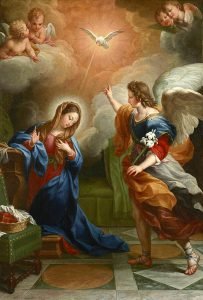 According to Matthew 4:11, after Jesus spent 40 days in the desert, “…the devil left him and, behold, angels came and ministered to him.” In Luke 22:43 an angel comforts Jesus Christ during the Agony in the Garden. In Matthew 28:5 an angel speaks at the empty tomb, following the Resurrection of Jesus and the rolling back of the stone by angels.
According to Matthew 4:11, after Jesus spent 40 days in the desert, “…the devil left him and, behold, angels came and ministered to him.” In Luke 22:43 an angel comforts Jesus Christ during the Agony in the Garden. In Matthew 28:5 an angel speaks at the empty tomb, following the Resurrection of Jesus and the rolling back of the stone by angels.
In 1851 Pope Pius IX approved the Chaplet of Saint Michael based on the 1751 reported private revelation from archangel Michael to the Carmelite nun Antonia d’Astonac. In a biography of Saint Gemma Galgani written by Venerable Germanus Ruoppolo, Galgani stated that she had spoken with her guardian angel.
Pope John Paul II emphasized the role of angels in Catholic teachings in his 1986 address titled “Angels Participate In History Of Salvation”, in which he suggested that modern mentality should come to see the importance of angels.
According to the Vatican’s Congregation for Divine Worship and Discipline of the Sacraments, “The practice of assigning names to the Holy Angels should be discouraged, except in the cases of Gabriel, Raphael and Michael whose names are contained in Holy Scripture.”
The New Church (Swedenborgianism)
The New Church denominations that arose from the writings of theologian Emanuel Swedenborg have distinct ideas about angels and the spiritual world in which they dwell. Adherents believe that all angels are in human form with a spiritual body, and are not just minds without form. There are different orders of angels according to the three heavens, and each angel dwells in one of innumerable societies of angels. Such a society of angels can appear as one angel as a whole.
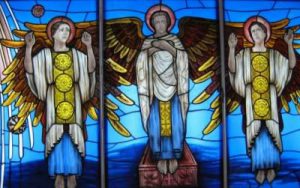 All angels originate from the human race, and there is not one angel in heaven who first did not live in a material body. Moreover, all children who die not only enter heaven but eventually become angels. The life of angels is that of usefulness, and their functions are so many that they cannot be enumerated. However each angel will enter a service according to the use that they had performed in their earthly life. Names of angels, such as Michael, Gabriel, and Raphael, signify a particular angelic function rather than an individual being.
All angels originate from the human race, and there is not one angel in heaven who first did not live in a material body. Moreover, all children who die not only enter heaven but eventually become angels. The life of angels is that of usefulness, and their functions are so many that they cannot be enumerated. However each angel will enter a service according to the use that they had performed in their earthly life. Names of angels, such as Michael, Gabriel, and Raphael, signify a particular angelic function rather than an individual being.
While living in one’s body an individual has conjunction with heaven through the angels, and with each person, there are at least two evil spirits and two angels. Temptation or pains of conscience originates from a conflict between evil spirits and angels. Due to man’s sinful nature it is dangerous to have open direct communication with angels and they can only be seen when one’s spiritual sight has been opened. Thus from moment to moment angels attempt to lead each person to what is good tacitly using the person’s own thoughts.
Latter Day Saints
The Latter Day Saint movement views angels as the messengers of God. They are sent to mankind to deliver messages, minister to humanity, teach doctrines of salvation, call mankind to repentance, give priesthood keys, save individuals in perilous times, and guide humankind.
 Latter Day Saints believe that angels either are the spirits of humans who are deceased or who have yet to be born, or are humans who have been resurrected or translated and have physical bodies of flesh and bones, and accordingly Joseph Smith taught that “there are no angels who minister to this earth but those that do belong or have belonged to it.” As such, Latter Day Saints also believe that Adam, the first man, was and is now the archangel Michael, and that Gabriel lived on the earth as Noah. Likewise the Angel Moroni first lived in a pre-Columbian American civilization as the 5th-century prophet-warrior named Moroni.
Latter Day Saints believe that angels either are the spirits of humans who are deceased or who have yet to be born, or are humans who have been resurrected or translated and have physical bodies of flesh and bones, and accordingly Joseph Smith taught that “there are no angels who minister to this earth but those that do belong or have belonged to it.” As such, Latter Day Saints also believe that Adam, the first man, was and is now the archangel Michael, and that Gabriel lived on the earth as Noah. Likewise the Angel Moroni first lived in a pre-Columbian American civilization as the 5th-century prophet-warrior named Moroni.
Smith described his first angelic encounter in the following manner:
While I was thus in the act of calling upon God, I discovered a light appearing in my room, which continued to increase until the room was lighter than at noonday, when immediately a personage appeared at my bedside, standing in the air, for his feet did not touch the floor.
He had on a loose robe of most exquisite whiteness. It was a whiteness beyond anything earthly I had ever seen; nor do I believe that any earthly thing could be made to appear so exceedingly white and brilliant …
Not only was his robe exceedingly white, but his whole person was glorious beyond description, and his countenance truly like lightning. The room was exceedingly light, but not so very bright as immediately around his person. When I first looked upon him, I was afraid; but the fear soon left me.
Most angelic visitations in the early Latter Day Saint movement were witnessed by Smith and Oliver Cowdery, who both said (prior to the establishment of the church in 1830) they had been visited by the prophet Moroni, John the Baptist, and the apostles Peter, James, and John. Later, after the dedication of the Kirtland Temple, Smith and Cowdery said they had been visited by Jesus, and subsequently by Moses, Elias, and Elijah.
Others who said they received a visit by an angel include the other two of the Three Witnesses: David Whitmer and Martin Harris. Many other Latter Day Saints, both in the early and modern church, have said they had seen angels, although Smith posited that, except in extenuating circumstances such as the restoration, mortals teach mortals, spirits teach spirits, and resurrected beings teach other resurrected beings.
Islam
Belief in angels is fundamental to Islam. The Quranic word for angel (Arabic: ملاك malak) derives either from Malaka, meaning “he controlled”, due to their power to govern different affairs assigned to them, or from the root either from ’-l-k, l-’-k or m-l-k with the broad meaning of a “messenger”, just like its counterparts in Hebrew (malʾákh) and Greek (angelos). Unlike their Hebrew counterpart, the term is exclusively used for heavenly spirits of the divine world, but not for human messengers. The Quran refers to both angelic and human messengers as “rasul” instead.
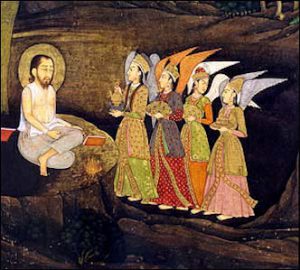 The Quran is the principal source for the Islamic concept of angels. Some of them, such as Gabriel and Michael, are mentioned by name in the Quran, others are only referred to by their function. In hadith literature, angels are often assigned to only one specific phenomena. Angels play a significant role in Mi’raj literature, where Muhammad encounters several angels during his journey through the heavens. Further angels have often been featured in Islamic eschatology, Islamic theology and Islamic philosophy. Duties assigned to angels include, for example, communicating revelations from God, glorifying God, recording every person’s actions, and taking a person’s soul at the time of death.
The Quran is the principal source for the Islamic concept of angels. Some of them, such as Gabriel and Michael, are mentioned by name in the Quran, others are only referred to by their function. In hadith literature, angels are often assigned to only one specific phenomena. Angels play a significant role in Mi’raj literature, where Muhammad encounters several angels during his journey through the heavens. Further angels have often been featured in Islamic eschatology, Islamic theology and Islamic philosophy. Duties assigned to angels include, for example, communicating revelations from God, glorifying God, recording every person’s actions, and taking a person’s soul at the time of death.
In Islam, just like in Judaism and Christianity, angels are often represented in anthropomorphic forms combined with supernatural images, such as wings, being of great size or wearing heavenly articles. The Quran describes them as “messengers with wings—two, or three, or four (pairs): He [God] adds to Creation as He pleases…” Common characteristics for angels are their missing needs for bodily desires, such as eating and drinking. Their lack of affinity to material desires is also expressed by their creation from light: Angels of mercy are created from nur (cold light) in opposition to the angels of punishment created from nar (hot light). Muslims do not generally share the perceptions of angelic pictorial depictions, such as those found in Western art.
Although believing in angels remain one of Six Articles of Faith in Islam, one can not find a dogmatic angelology in Islamic tradition. Despite this, scholars had discussed the role of angels from specific canonical events, such as the Mi’raj, and Quranic verses. Even if they are not in focus, they have been featured in folklore, philosophy debates and systematic theology. While in classical Islam, widespread notions were accepted as canonical, there is a tendecy in contemporary scholarship to reject much material about angels, like calling the Angel of Death by the name Azra’il.
Ibn Sina, who drew upon the Neo-Platonistic emanation cosmology of Al-Farabi, developed an angelological hierarchy of Intellects, which are created by “the One”. Therefore, the first creation by God was the supreme archangel followed by other archangels, who are identified with lower Intellects. From these Intellects again, emanated lower angels or “moving spheres”, from which in turn, emanated other Intellects until it reaches the Intellect, which reigns over the souls. The tenth Intellect is responsible for bringing material forms into being and illuminating the minds.
In Folk Islam, individual angels may be evoked in exorcism rites, whose names are engraved in talismans or amulets.
Some modern scholars have emphasized a metaphorical reinterpretation of the concept of angels.
Zoroastrianism
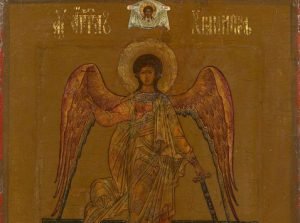 In Zoroastrianism there are different angel-like figures. For example, each person has one guardian angel, called Fravashi. They patronize human beings and other creatures, and also manifest God’s energy. The Amesha Spentas have often been regarded as angels, although there is no direct reference to them conveying messages, but are rather emanations of Ahura Mazda (“Wise Lord”, God); they initially appeared in an abstract fashion and then later became personalized, associated with diverse aspects of the divine creation.
In Zoroastrianism there are different angel-like figures. For example, each person has one guardian angel, called Fravashi. They patronize human beings and other creatures, and also manifest God’s energy. The Amesha Spentas have often been regarded as angels, although there is no direct reference to them conveying messages, but are rather emanations of Ahura Mazda (“Wise Lord”, God); they initially appeared in an abstract fashion and then later became personalized, associated with diverse aspects of the divine creation.
Neoplatonism
In the commentaries of Proclus (4th century) on the Timaeus of Plato, Proclus uses the terminology of “angelic” (aggelikos) and “angel” (aggelos) in relation to metaphysical beings. According to Aristotle, just as there is a Prime Mover, so, too, must there be spiritual secondary movers.
Sikhism
The poetry of the holy scripture of the Sikhs – the Sri Guru Granth Sahib – figuratively mentions a messenger or angel of death, sometimes as Yam (ਜਮ – “Yam”) and sometimes as Azrael (ਅਜਰਾਈਲੁ – “Ajraeel”):
 ਜਮ ਜੰਦਾਰੁ ਨ ਲਗਈ ਇਉ ਭਉਜਲੁ ਤਰੈ ਤਰਾਸਿ
ਜਮ ਜੰਦਾਰੁ ਨ ਲਗਈ ਇਉ ਭਉਜਲੁ ਤਰੈ ਤਰਾਸਿ
The Messenger of Death will not touch you; in this way, you shall cross over the terrifying world-ocean, carrying others across with you.
— Sri Guru Granth Sahib, Siree Raag, First Mehl, p. 22.
ਅਜਰਾਈਲੁ ਯਾਰੁ ਬੰਦੇ ਜਿਸੁ ਤੇਰਾ ਆਧਾਰੁ
Azraa-eel, the Messenger of Death, is the friend of the human being who has Your support, Lord.
— Sri Guru Granth Sahib, Tilang, Fifth Mehl, Third House, p. 724.
In a similar vein, the Sri Guru Granth Sahib talks of a figurative Chitar (ਚਿਤ੍ਰ) and Gupat (ਗੁਪਤੁ):
ਚਿਤ੍ਰ ਗੁਪਤੁ ਸਭ ਲਿਖਤੇ ਲੇਖਾ ॥
ਭਗਤ ਜਨਾ ਕਉ ਦ੍ਰਿਸਟਿ ਨ ਪੇਖਾ
Chitar and Gupat, the recording angels of the conscious and the unconscious, write the accounts of all mortal beings, / but they cannot even see the Lord’s humble devotees.
— Sri Guru Granth Sahib, Aasaa, Fifth Mehl, Panch-Pada, p. 393.
However, Sikhism has never had a literal system of angels, preferring guidance without explicit appeal to supernatural orders or beings.
Related Posts
Features
Copyright © 2018 SEAN-O-VISTA

Powered with 

